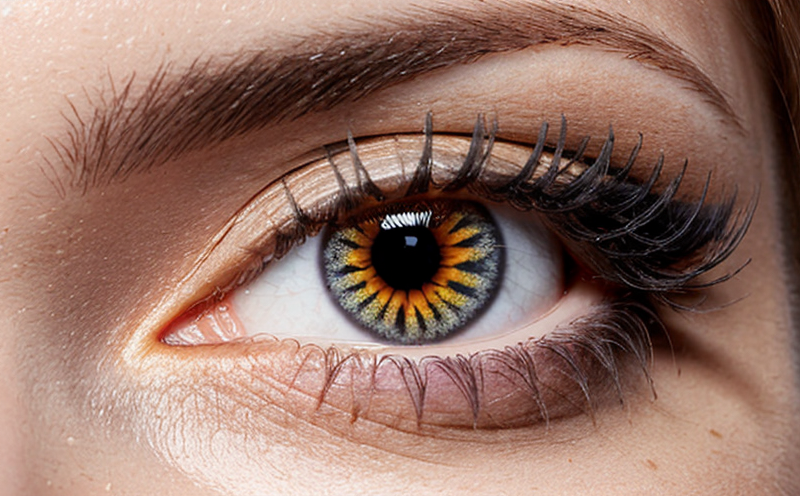Ocular Safety Assessment for Cosmetic Eye Concealers
The ocular safety assessment of cosmetic eye concealer products is a critical step in ensuring the quality and safety of these cosmetics. This service involves evaluating the potential irritant effects that the product may have on the eyes, which are particularly sensitive organs.
Cosmetic eye concealers are often worn close to the eyelids and can come into direct contact with the cornea and conjunctiva. The ocular safety assessment aims to identify any adverse effects that could arise from prolonged or repeated exposure of these products to the eyes. This service is essential for ensuring consumer protection, compliance with international standards, and maintaining brand reputation.
The ocular irritation test typically follows a standardized protocol such as ISO 10993-11:2018. This standard provides specific guidelines on how to conduct tests that assess the potential of a cosmetic product to cause irritation or damage when in direct contact with the eye area.
The testing process involves applying small quantities of the cosmetic sample to the conjunctiva and cornea of rabbits under controlled conditions for a specified period. The animals are then observed for signs of irritation, such as redness, swelling, discharge, or changes in behavior indicating discomfort. If no adverse effects are observed within a predetermined time frame, the product is considered safe for use around the eyes.
This assessment is not only crucial for regulatory compliance but also plays a vital role in brand reputation and consumer confidence. Many consumers today prefer to know that their products have undergone rigorous testing before being placed on the market. This transparency can significantly enhance trust between brands and customers, leading to increased sales and loyalty.
Furthermore, ocular safety assessments are an integral part of a broader quality assurance program within cosmetic manufacturing companies. They help in identifying potential issues early in the development process, allowing for necessary adjustments and improvements before the product reaches the market.
- Reduction in Risk: By conducting ocular safety assessments, manufacturers can minimize the risk of legal actions due to consumer complaints or injuries resulting from the use of their products. This proactive approach helps in maintaining a positive public image and compliance with regulatory requirements.
- Enhanced Consumer Trust: Brands that invest in thorough testing are more likely to gain consumer trust, which is essential for long-term success in the competitive cosmetics market.
- Compliance with International Standards: Adherence to standards such as ISO 10993-11 ensures consistency and reliability of test results across different regions, facilitating easier regulatory compliance globally.
In conclusion, ocular safety assessments for cosmetic eye concealers are not just a procedural requirement; they represent a commitment to consumer health and well-being. By rigorously testing these products, manufacturers can ensure that they meet the highest standards of quality and safety, thereby protecting their brand reputation and fostering trust among consumers.
Scope and Methodology
The scope of ocular safety assessments for cosmetic eye concealer products is broad but focuses on evaluating the potential irritant effects that these products may have when used around the eyes. This service ensures that the products are safe for consumer use, particularly in sensitive areas like the eyelids and surrounding regions.
Our methodology adheres strictly to international standards such as ISO 10993-11:2018, which provides comprehensive guidelines on how to conduct these assessments. The process involves several key steps:
- Sample Preparation: We receive the cosmetic eye concealer samples from our clients and prepare them according to the specified requirements outlined in ISO 10993-11:2018.
- Application Procedure: The prepared samples are then applied to the conjunctiva of rabbits under controlled conditions. This step is designed to mimic real-world usage scenarios as closely as possible.
- Observation Period: After application, the animals are observed for a specified period to monitor any signs of irritation or adverse effects. This period allows us to detect even subtle changes in behavior that might indicate discomfort or injury.
- Data Analysis and Reporting: Once the observation period ends, our team thoroughly analyzes all collected data. Based on this analysis, we prepare a detailed report outlining the findings of the ocular safety assessment.
The methodology is designed to be thorough yet efficient, ensuring that each step contributes effectively towards achieving accurate and reliable results. This approach not only meets regulatory requirements but also provides valuable insights into the potential risks associated with using these products around the eyes.
Eurolab Advantages
At Eurolab, we pride ourselves on providing top-tier ocular safety assessments for cosmetic eye concealer products. Our service is renowned for its reliability, accuracy, and adherence to international standards.
- Compliance with International Standards: We ensure that all our tests comply with the latest ISO 10993-11:2018 guidelines, guaranteeing accurate and reliable results.
- Experienced Professionals: Our team comprises highly skilled professionals who are experts in cosmetic testing. Their expertise ensures that we deliver comprehensive assessments tailored to each client's needs.
- State-of-the-Art Facilities: Equipped with advanced laboratory facilities, Eurolab provides a controlled environment for conducting ocular safety tests, ensuring consistent and accurate results.
- Rapid Turnaround Time: We understand the importance of timely delivery in the competitive cosmetics market. Eurolab offers quick turnaround times without compromising on quality.
Our commitment to excellence sets us apart from other testing laboratories, making us a preferred choice for cosmetic manufacturers seeking reliable and accurate ocular safety assessments.





